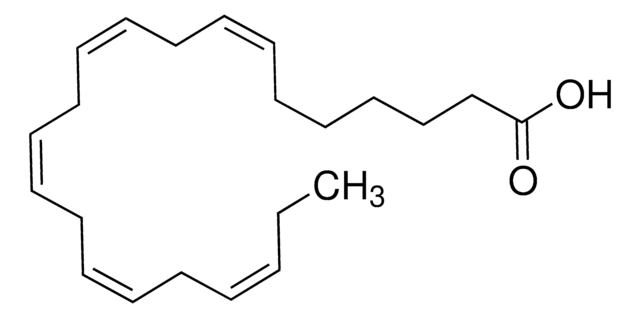72709
Atto 488 azide
BioReagent, suitable for fluorescence, ≥90% (HPLC)
Sign Into View Organizational & Contract Pricing
All Photos(1)
About This Item
UNSPSC Code:
12352125
NACRES:
NA.32
Recommended Products
product line
BioReagent
Assay
≥90% (HPLC)
form
solid
mol wt
Mw 903 g/mol
manufacturer/tradename
ATTO-TEC GmbH
λ
in methanol: water (1:1) (with 0.1% perchloric acid)
UV absorption
λ: 501-507 nm Amax
suitability
suitable for fluorescence
storage temp.
−20°C
General description
Atto 488 is a superior fluorescence label with high molecular absorption (90.000) and quantum yield (0.80) as well as sufficient stoke′s shift. It is optimised for excitation with argon laser, and is characterized by high photo stability.
The azide modification is suitable for reactions with alkyne groups (Huisgen reaction - "Click Chemistry").
The azide modification is suitable for reactions with alkyne groups (Huisgen reaction - "Click Chemistry").
Legal Information
This product is for Research use only. In case of intended commercialization, please contact the IP-holder (ATTO-TEC GmbH, Germany) for licensing.
Storage Class Code
11 - Combustible Solids
WGK
WGK 3
Flash Point(F)
Not applicable
Flash Point(C)
Not applicable
Personal Protective Equipment
dust mask type N95 (US), Eyeshields, Gloves
Certificates of Analysis (COA)
Search for Certificates of Analysis (COA) by entering the products Lot/Batch Number. Lot and Batch Numbers can be found on a product’s label following the words ‘Lot’ or ‘Batch’.
Already Own This Product?
Find documentation for the products that you have recently purchased in the Document Library.
Customers Also Viewed
Monitoring single membrane protein dynamics in a liposome manipulated in solution by the ABELtrap.
Rendler, T., et al.
arXiv, 1102-1102 (2011)
Analysis of fluorescent nanostructures in biological systems by means of spectral position determination microscopy (SPDM).
Muller, P., et al. et al.
Current Microscopy Contributions to Advances in Science and Technology, 1, 3-12 (2012)
E Pourkarimi et al.
Cell death and differentiation, 19(3), 406-415 (2011-09-03)
In C. elegans, the BH3-only domain protein EGL-1, the Apaf-1 homolog CED-4 and the CED-3 caspase are required for apoptosis induction, whereas the Bcl-2 homolog CED-9 prevents apoptosis. Mammalian B-cell lymphoma 2 (Bcl-2) inhibits apoptosis by preventing the release of
Markus Hirsch et al.
Biological chemistry, 393(1-2), 23-35 (2012-05-26)
Investigations into the fate of small interfering RNA (siRNA) after transfection may unravel new ways to improve RNA interference (RNAi) efficiency. Because intracellular degradation of RNA may prevent reliable observation of fluorescence-labeled siRNA, new tools for fluorescence microscopy are warranted
Jeanne C Stachowiak et al.
Nature cell biology, 14(9), 944-949 (2012-08-21)
Curved membranes are an essential feature of dynamic cellular structures, including endocytic pits, filopodia protrusions and most organelles. It has been proposed that specialized proteins induce curvature by binding to membranes through two primary mechanisms: membrane scaffolding by curved proteins
Our team of scientists has experience in all areas of research including Life Science, Material Science, Chemical Synthesis, Chromatography, Analytical and many others.
Contact Technical Service






